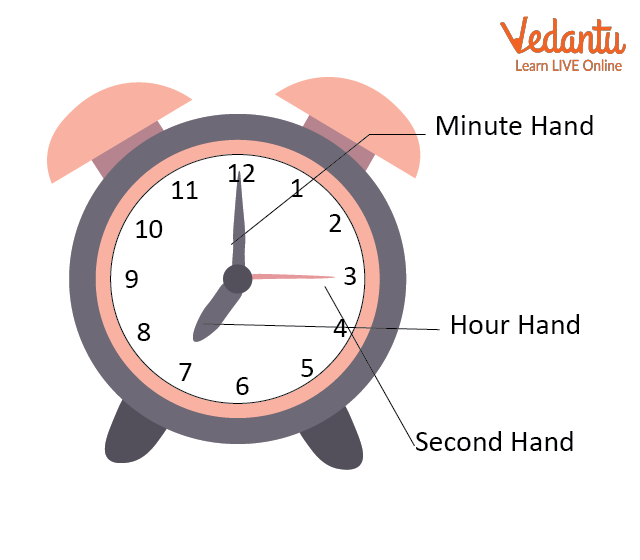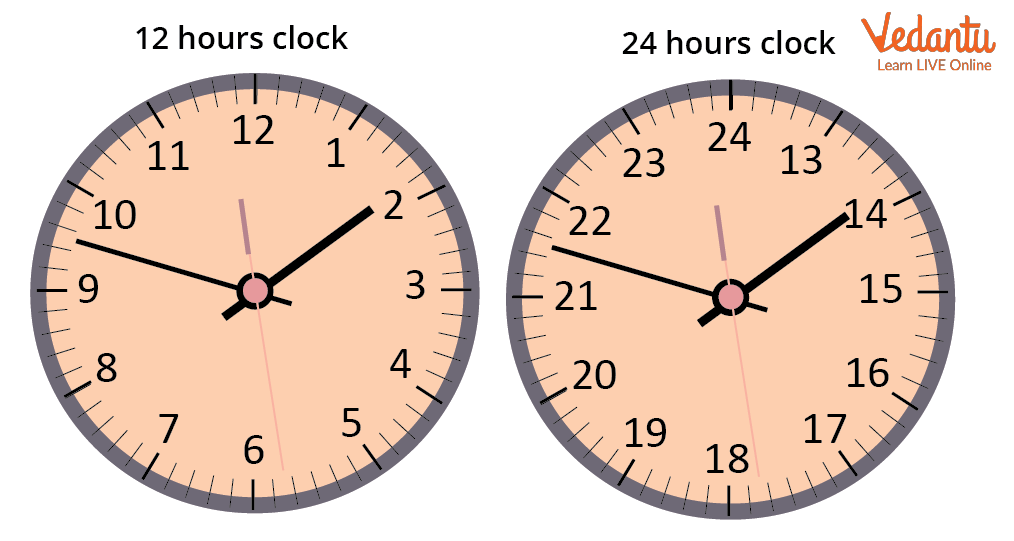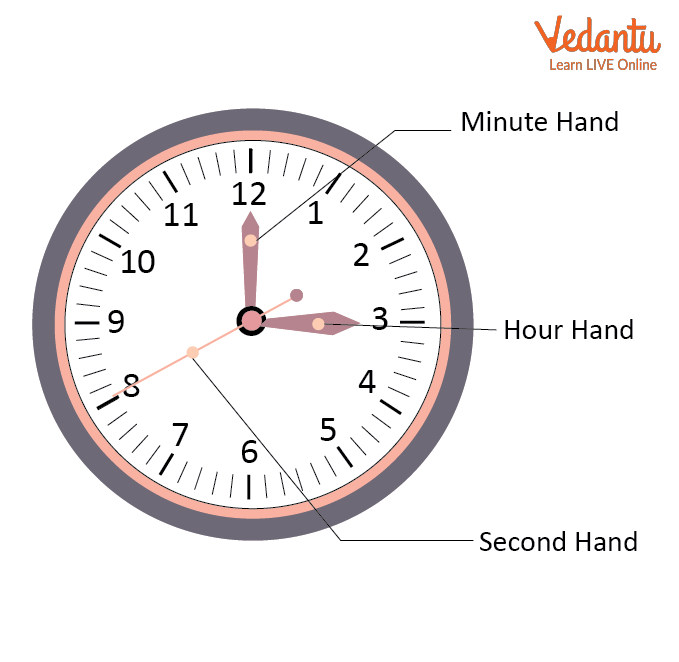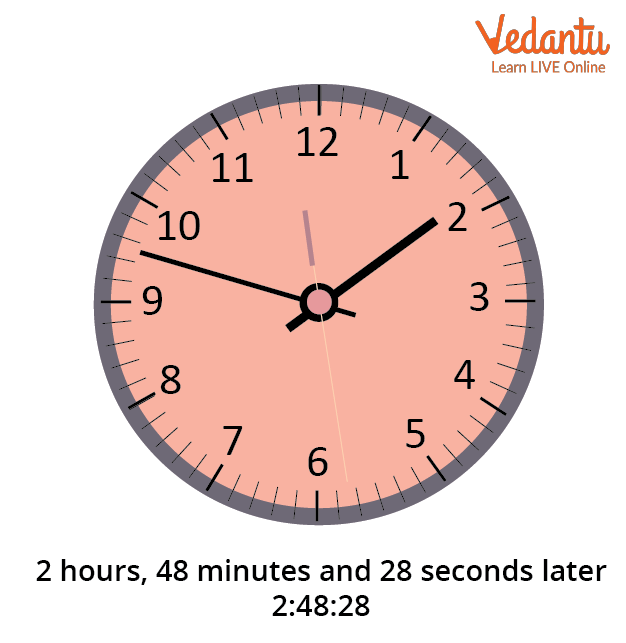




How to Convert Seconds to Hours Quickly with Examples
We all have seen three hands on a clock face. The minute hand indicates the time in minutes, the hour hand indicates the time in hours, and the second hand shows the time in seconds. There are 12 central divisions on the clock, each lasting one hour, and five minor divisions spaced equally between them.
Five minutes are passed when the minute hand transitions from one large division to the subsequent large division. Each of the 12 significant divisions lasts five minutes, making the equation for an hour: 12 x 5 = 60 minutes.
Time is the eternal progression of past, present, and future events, indicating that time comprises every series of events that have occurred or will occur in the future. It is measured in minutes, seconds, and hours. The clock is used to measure time more precisely and accurately.
What Is a Clock?
The clock is a device for measuring the time that displays the passage of hours, minutes, and seconds.

Clock
The units used to measure time are the hour, minute, and second. The minute hand is the largest and fastest hand on the clock, followed by the second hand and the Hour hand.
Time
Time is defined as the duration of all events or the specific instant that something occurs. Time includes all events that have occurred or will occur in the future.
Time is written as- Hour: Minutes: Seconds.
Example: 02: 48:28

Time keeper
Two Different Types of Clocks
Clock with a 12-hour format: As the name implies, this clock displays time from 1 to 12. These clocks lack digital displays, and the wall clocks are an example.
Clock in 24-hour format: This clock displays the time from 1 to 24 as its name says. These clocks are digital, and some wrist-watches, railway’s digital clocks, etc. are examples of such clock format.
In a 12-hour clock, the entire 24-hour period is divided into two segments, from midnight to noon and from midday to midnight. Ante Meridiem, or before noon, is what "A.M." stands for. As a result, we add the A.M. suffix to the time from midnight to noon. For instance, we might say that it is 9 am. Post Meridiem, or "afternoon," is what "P.M." stands for. As a result, we add the P.M. suffix to the end of the time from noon to midnight, for instance, 4 p.m.

Hour, Minute, and Seconds Hands
Seconds to Hours Formula
To convert from seconds to hours, divide the number of seconds by 3600.
For instance:
Convert 60 seconds in an hour.
As we know the seconds to hours formula, we need to divide the given time by 3600. Since, here we have 60 seconds, 60 divided by 3600 will give us 0.016 hours.
Conversions:
- 1 Hour = 60 Minutes
- 1 Minute =$\dfrac{1}{60}$ Hour
- 1 Minute = 60 Seconds
- 1 Second = $\dfrac{1}{60}$ Minutes
How to Convert Seconds to Minutes
To change seconds to minutes, multiply the digit by 60. Simply reverse the process of converting minutes to seconds if you start from seconds and need to convert to minutes. To change secs to mins, divide by 60.
For instance:
30 secs divided by 60 mins equals 0.5 mins.
One minute and 30 seconds are identical to 90 seconds.
How to Convert Minutes to Seconds
Keep in mind that one minute consists of 60 seconds. Remember the magic number: 60 seconds for every minute before you begin your conversion. It will be much simpler to convert if you keep this in mind.
For instance:
Change 5 min 37 sec into seconds.
Solution: 1 min = 60 sec
Thus, 5 min = 5 x 60 = 300 sec.
5 min 37 sec = 300 sec + 37 sec = 337 seconds
Solved Examples
Example 1: Convert 270 minutes into seconds.
Ans: We know that one hour is equal to 60 minutes.
Additionally, we know that one minute equals 60 seconds.
Thus, 270 minutes equals 270 x 60, or 16,200 seconds.
Example 2: Convert 4800 seconds into hours.
Ans: First, we need to convert seconds into minutes and then minutes into hours.
$= 4800 \text{ seconds }= \left(4800 \div 60)\text{ minutes }(1\text{ second }=\dfrac{1}{60}\text{ minute}\right)$
$= 80$minutes
$= 80 \div 60$ hours $\left(\text{ minute }=\dfrac{1}{60}\text{ hour}\right)$
= 1 hour 20 minutes
Example 3: Convert 36000 seconds into hours.
Ans: First, we have to convert seconds into minutes and then minutes into hours.
$= 36000 \text{ seconds }= \left(3600 \div 60)\text{ minutes }(1\text{ second }=\dfrac{1}{60}\text{ minute}\right)$
$= 600$minutes
$= 600 \div 60$ hours $\left(\text{ minute }=\dfrac{1}{60}\text{ hour}\right)$
= 10 hours

Hands of a Clock
Try on Your Own
Q1. How many minutes are in 600 seconds?
Ans: 10 minutes are in 600 seconds
Q2. Convert 7300 seconds to minutes to hours.
Ans: 7,300 Seconds = 2.0277 Hours = 2 Hours, 1 Minute and 39 Seconds.
Summary
Time is the continued ongoing growth of past, present, and future scenes. It simply means every sequence of events that has happened, which is occurring or will happen, is created by time. It is estimated in hours, minutes, and seconds. The device used to measure time is known as a clock. The hour hand is the smallest and slowest in the watch, then comes the second hand, and the largest is the minute hand.
FAQs on Convert Seconds to Hours – Step-by-Step Guide
1. What is the equation to convert seconds to hours?
To convert seconds to hours, use the equation:
$$ \text{Hours} = \frac{\text{Seconds}}{3600} $$
This is because 1 hour = 3600 seconds. For example, to convert 7200 seconds to hours:
$$ \text{Hours} = \frac{7200}{3600} = 2 \text{ hours} $$
Vedantu provides interactive sessions to help you understand and practice such conversions easily in mathematics and science subjects at all academic levels.
2. What is the equation for converting hours to seconds?
To convert hours to seconds, multiply the number of hours by 3600. The equation is:
$$ \text{Seconds} = \text{Hours} \times 3600 $$
For example, converting 3 hours to seconds:
$$ \text{Seconds} = 3 \times 3600 = 10,800 \text{ seconds} $$
Vedantu's expert tutors can guide you through more such unit conversions and help improve your problem-solving skills.
3. How to convert 1 s to 1 h?
To convert 1 second to hours, divide by 3600 since there are 3600 seconds in an hour:
$$ 1 \text{ s} = \frac{1}{3600} \text{ h} \approx 0.00027778 \text{ h} $$
This small value reflects how many hours just one second makes up. Vedantu provides step-by-step guidance for such math and science conversions, helping students build conceptual understanding.
4. Is 7200 seconds 2 hours?
Yes, 7200 seconds is equal to 2 hours. You can check this by dividing 7200 by the number of seconds in an hour (3600):
$$ \frac{7200}{3600} = 2 \text{ hours} $$
Vedantu’s study materials make it easy to learn and practice time conversions and other foundational math concepts.
5. How do you convert minutes and seconds into hours?
To convert minutes and seconds into hours:
- Convert minutes to seconds: $\text{Minutes} \times 60$
- Add all seconds together
- Divide the total by 3600
$$ \text{Hours} = \frac{(\text{Minutes} \times 60) + \text{Seconds}}{3600} $$
Vedantu’s interactive sessions include numerous examples and practice problems that help reinforce these conversion skills.
6. What is an easy trick to remember seconds to hours conversion?
A simple trick to remember seconds to hours conversion is:
- There are 3600 seconds in 1 hour.
- To find hours, divide the number of seconds by 3600.
3600 seconds = 1 hour, 1800 seconds = 0.5 hour, and 7200 seconds = 2 hours. Vedantu teachers use similar memory aids to make unit conversions effortless for students.
7. How can you convert decimal hours to seconds?
To convert decimal hours to seconds, multiply the decimal hour value by 3600:
$$ \text{Seconds} = \text{Decimal\ Hours} \times 3600 $$
For example, 1.5 hours would be:
$$ 1.5 \times 3600 = 5400 \text{ seconds} $$
Vedantu’s curriculum covers both decimal and fractional time conversions for comprehensive learning.
8. Why is it important to understand time conversions in math and science?
Understanding time conversions is essential in math and science because:
- Many calculations in physics, chemistry, and everyday life require conversion between units of time.
- Accurate conversions are necessary for solving problems related to speed, rate, and scheduling.
- It enhances logical thinking and foundation for advanced topics.
9. Can Vedantu help with practice problems on converting seconds to hours?
Absolutely! Vedantu offers a wide variety of practice problems and interactive quizzes that focus on converting seconds to hours and other unit conversions. These resources help students master the concept through guided examples and immediate feedback, building confidence and proficiency in mathematics.
10. What are some real-life examples where converting seconds to hours is used?
Converting seconds to hours is useful in various scenarios, such as:
- Calculating total travel time for journeys measured in seconds.
- Understanding durations in scientific experiments or data logging.
- Time tracking for exercise, sports, or project tasks.























